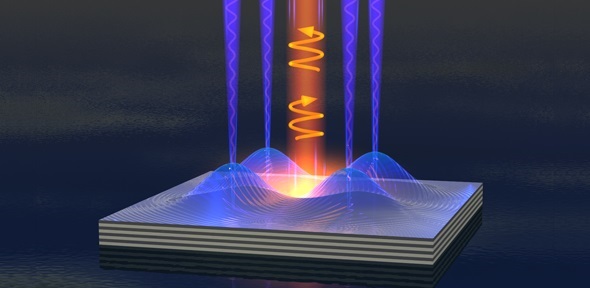08 Aug 2016
Researchers have built a record energy-efficient switch, which uses the interplay of electricity and a liquid form of light, in semiconductor microchips. The device could form the foundation of future signal processing and information technologies, making electronics even more efficient.
Researchers have built a miniature electro-optical switch which can change the spin – or angular momentum – of a liquid form of light by applying electric fields to a semiconductor device a millionth of a metre in size. Their results, reported in the journal Nature Materials, demonstrate how to bridge the gap between light and electricity, which could enable the development of ever faster and smaller electronics.
There is a fundamental disparity between the way in which information is processed and transmitted by current technologies. To process information, electrical charges are moved around on semiconductor chips; and to transmit it, light flashes are sent down optical fibres. Current methods of converting between electrical and optical signals are both inefficient and slow, and researchers have been searching for ways to incorporate the two.
In order to make electronics faster and more powerful, more transistors need to be squeezed onto semiconductor chips. For the past 50 years, the number of transistors on a single chip has doubled every two years – this is known as Moore’s law. However, as chips keep getting smaller, scientists now have to deal with the quantum effects associated with individual atoms and electrons, and they are looking for alternatives to the electron as the primary carrier of information in order to keep up with Moore’s law and our thirst for faster, cheaper and more powerful electronics.
The University of Cambridge researchers, led by Professor Jeremy Baumberg from the NanoPhotonics Centre, in collaboration with researchers from Mexico and Greece, have built a switch which utilises a new state of matter called a Polariton Bose-Einstein condensate in order to mix electric and optical signals, while using miniscule amounts of energy.
Polariton Bose-Einstein condensates are generated by trapping light between mirrors spaced only a few millionths of a metre apart, and letting it interact with thin slabs of semiconductor material, creating a half-light, half-matter mixture known as a polariton.
Putting lots of polaritons in the same space can induce condensation – similar to the condensation of water droplets at high humidity – and the formation of a light-matter fluid which spins clockwise (spin-up) or anticlockwise (spin-down). By applying an electric field to this system, the researchers were able to control the spin of the condensate and switch it between up and down states. The polariton fluid emits light with clockwise or anticlockwise spin, which can be sent through optical fibres for communication, converting electrical to optical signals.
“The polariton switch unifies the best properties of electronics and optics into one tiny device that can deliver at very high speeds while using minimal amounts of power,” said the paper’s lead author Dr Alexander Dreismann from Cambridge’s Cavendish Laboratory.
“We have made a field-effect light switch that can bridge the gap between optics and electronics,” said co-author Dr Hamid Ohadi, also from the Cavendish Laboratory. “We’re reaching the limits of how small we can make transistors, and electronics based on liquid light could be a way of increasing the power and efficiency of the electronics we rely on.”
While the prototype device works at cryogenic temperatures, the researchers are developing other materials that can operate at room temperature, so that the device may be commercialised. The other key factor for the commercialisation of the device is mass production and scalability. “Since this prototype is based on well-established fabrication technology, it has the potential to be scaled up in the near future,” said study co-author Professor Pavlos Savvidis from the FORTH institute in Crete, Greece.
The team is currently exploring options for commercialising the technology as well as integrating it with the existing technology base.
The research is funded as part of a UK Engineering and Physical Sciences Research Council (EPSRC) investment in the Cambridge NanoPhotonics Centre, as well as the European Research Council (ERC) and the Leverhulme Trust.
Reference:
A. Dreismann et al. ‘A sub-femtojoule electrical spin-switch based on optically trapped polariton condensates.’ Nature Materials (2016). DOI: 10.1038/nmat4722
This work is licensed under an attribution, noncommercial, share-alike Creative Commons Licence. The original article can be read at
www.cam.ac.uk/research
http://www.cam.ac.uk/research/news/liquid-light-switch-could-enable-more-powerful-electronics















